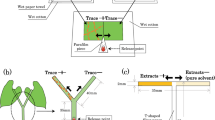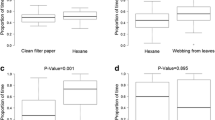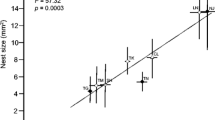Abstract
Tetranychus urticae (the two-spotted spider mite) is a phytophagous agricultural pest that affects many economically important crops. Two-spotted spider mites are group-living arachnids that produce silk webbing which is used for protection and dispersal, and also influences settlement behavior of conspecifics. We investigated the effects of conspecific silk and frass on microhabitat selection of these mites and whether these materials are substrates for semiochemicals. Two-choice behavioral assays gave mites the option of settling in the presence or absence of cues produced by conspecifics. Both sexes of mites preferred to settle in the presence of silk produced by conspecific females, and males also responded positively to silk produced by other males. Frass alone had no effect on mite settlement choices, but mites tended to prefer frass in combination with silk over silk alone. Female mites did not respond to conspecific silk after it was washed with methanol, and a crude methanol extract of the silk was sufficient to elicit settlement behavior, confirming that a semiochemical is responsible for the effect. We conclude that silk-bound semiochemicals provide cues used by both male and female mites when selecting a microhabitat, and that frass may also provide relevant social cues.




Similar content being viewed by others
Data Availability
Raw data included as a supplementary file.
Code Availability
Not applicable.
References
Bernard A, Krafft B (2002) Silk attraction: base of group cohesion and collective behaviours in social spiders. C R Biol 325:1153–1157
Blomquist GJ, Figueroa-Teran R, Aw M, Song M, Gorzalski A, Abbott NL, Chang E, Tittiger C (2010) Pheromone production in bark beetles. Insect Biochem Mol Biol 40:699–712
CABI (2019) Tetranychus urticae (two-spotted spider mite). Invasive Species Compendium. https://www.cabi.org/isc/datasheet/53366#toidentity. Accessed 1 Apr 2021
Carr AL, Roe M (2016) Acarine attractants: chemoreception, bioassay, chemistry and control. Pestic Biochem Phys 131:60–79
Clotuche G, Deneubourg J-L, Mailleux A-C, Detrain C, Hance T (2012) Discrimination through silk recognition: The case of the two-spotted spider mite Tetranychus urticae C R Biol 335:535–540
Clotuche G, Turlure C, Mailleux A-C, Detrain C, Hance T (2013a) Should I lay or should I wait? Egg-laying in the two-spotted spider mite Tetranychus urticae Koch. Behav Processes 92:24–30
Clotuche G, Navajas M, Mailleux A-C, Hance T (2013b) Reaching the ball or missing the flight? Collective dispersal in the two-spotted spider mite Tetranychus urticae PLoS ONE 8:e77573
Clotuche G, Mailleux A-C, Yano S, Detrain C, Deneubourg J-L, Hance T (2013c) Settlement decisions by the two-spotted spider mite Tetranychus urticae C R Biol 336:93–101
Clotuche G, Yano S, Akino T, Amano H (2014) Chemical investigation of aggregation behaviour in the two-spotted spider mite Tetranychus urticae Exp Appl Acarol 63:377–387
Colasurdo N, Despland E (2005) Social cues and following behaviour in the forest tent caterpillar. J Insect Behav 18:77–87
Cone WW, Predki S, Klostermeyer EC (1971) Pheromone studies of the two-spotted spider mite. 2. Behavioural response of males to quiescent deutonymphs. J Econ Entomol 64:379–382
Fletcher R, Miller C (2006) Emergent properties of conspecific attraction in fragmented landscapes. Am Nat 168:207–219
Gaskett AC (2007) Spider sex pheromones: emission, reception, structures, and functions. Biol Rev 82:27–48
Gerson U (1985) Webbing. In: Helle W, Sabelis MW (eds) Spider mites, their biology, natural enemies and control, vol 1A. Elsevier, Amsterdam, pp 223–233
Gonzalo A, Cabido C, Galan P, Lopez P, Martín J (2006) Predator, but not conspecific, chemical cues influence pond selection by recently metamorphosed Iberian green frogs, Rana perezi Can J Zool 84:1295–1299
Jeanson R, Deneubourg J-L, Theraulaz G (2004) Discrete dragline attachment induces aggregation in spiderlings of a solitary species. Anim Behav 67:531–537
Krafft B, Cookson LJ (2012) The role of silk in the behaviour and sociality of spiders. Psyche 2012:529564
Landolt PJ (1997) Sex attractant and aggregation pheromones of male phytophagous insects. Am Entomol 43:12–22
Le Goff GJ, Hance T, Detrain C, Deneubourg J-L, Clotuche G, Mailleux AC (2012) Impact of starvation on the silk attractiveness in a weaving mite, Tetranychus urticae (Acari: Tetranychidae). J Ethol 30:125–132
Lorenzo MG, Lazzari CR (1996) The spatial pattern of defaecation in Triatoma infestans and the role of faeces as a chemical mark of the refuge. J Insect Physiol 42:903–907
Margolies DC, Collins RD (1994) Chemically-mediated pre-mating behavior in two tetranychid species. Exp Appl Acarol 18:493–501
Martini X, Guvvala H, Nansen C (2015) The search behavior of omnivorous thrips larvae is influenced by spider mite cues. J Insect Behav 28:593–603
Mukhin A, Chernetsov N, Kishkinev D (2008) Acoustic information as a distant cue for habitat recognition by nocturnally migrating passerines during landfall. Behav Ecol 19:716723
Muller KL (1998) The role of conspecifics in habitat selection in a territorial grasshopper. Anim Behav 56:479–485
Oku K (2009) Female mating strategy during precopulatory mate guarding in spider mites. Anim Behav 77:207–211
Oku K, Weldegergis BT, Poelman EH, De Jong PW, Dicke M (2015) Altered volatile profile associated with precopulatory mate guarding attracts spider mite males. J Chem Ecol 41:187–193
Penman DR, Cone WW (1974) Role of web, tactile stimuli and female sex pheromone in attraction of male two-spotted spider mites to quiescent female deutonymphs. Ann Entomol Soc Am 67:179–182
Potter DA, Wrensch DL, Johnston DE (1976) Guarding, aggressive behavior, and mating success in male twospotted spider mites. Ann Entomol Soc Am 69:707–711
R Core Team (2020) R: A language and environment for statistical computing. R Foundation for Statistical Computing, Vienna
Reed JM, Dobson AP (1993) Behavioural constraints and conservation biology: conspecific attraction and recruitment. Trends Ecol Evol 8:253–256
Rodrigues LR, Figueiredo AR, Van Leeuwen T, Olivieri I, Magalhães S (2020) Costs and benefits of multiple mating in a species with first-male sperm precedence. J Anim Ecol 89(4):1045–1054
Sabelis MW, Bakker FM (1992) How predatory mites cope with the web of their tetranychid prey: a functional view on dorsal chaetotaxy in the Phytoseiidae. Exp Appl Acarol 16:203–225
Saffre F, Furey R, Krafft B, Deneubourg JL (1999) Collective decision making in social spiders: dragline-mediated amplification process acts as a recruitment mechanism. J Theor Biol 198:507–517
Saito Y (1977) Study on the spinning behaviour of the spider mite (Acarina: Tetranychidae). I. Method for the quantitative evaluation of the mite webbing, and the relationship between webbing and walking. Jpn J Appl Entomol 21:27–34
Schuck-Paim C, Alonso WJ (2001) Deciding where to settle: conspecific attraction and web site selection in the orb-web spider Nephilengys cruentata Anim Behav 62:1007–1012
Scott CE, Anderson AG, Andrade MCB (2018) A review of the mechanisms and functional roles of male silk use in spider courtship and mating. J Arachnol 46:173–206
Segura DF, Viscarret MM, Paladino LZC, Ovruski SM, Cladera JL (2007) Role of visual information and learning in habitat selection by a generalist parasitoid foraging for concealed hosts. Anim Behav 74:131–142
Segura DF, Viscarret MM, Ovruski SM, Cladera JL (2012) Response of the fruit fly parasitoid Diachasmimorpha longicaudata to host and host-habitat volatile cues. Entomol Exp Appl 143:164–176
Walker KA, Jones TH, Fell RD (1993) Pheromonal basis of aggregation in European earwig, Forficula auricularia L.(Dermaptera: Forficulidae). J Chem Ecol 19:2029–2038
Woodbury N, Gries G (2008) Amber-colored excreta: a source of arrestment pheromone in firebrats, Thermobia domestica Entomol Exp Appl 127:100–107
Yano S (2008) Collective and solitary behaviors of two-spotted spider mite (Acari: Tetranychidae) are induced by trail following. Ann Entomol Soc Am 101:247–252
Yano S (2012) Cooperative web sharing against predators promotes group living in spider mites. Behav Ecol Sociobiol 66:845–853
Acknowledgements
We would like to acknowledge that this work was conducted in Mi’kma’ki, the ancestral and unceded territory of the Mi’kmaq. We thank T Peskett, S McCann, and all members of the INSECTA lab for assistance and support. This study was completed in partial fulfilment of the requirements for a Bachelor of Science with Honours in the Department of Biology at Acadia University.
Funding
This work was supported by NSERC (RGPIN-2017-04319 to NKH), Atlantic Canada Opportunities Agency Atlantic Innovation Fund (197853 to NKH), Eco Canada, Acadia University, and the K.C. Irving Environmental Science Centre.
Author information
Authors and Affiliations
Contributions
Conceptualization: GRB, CES, NKH; Data collection and analyses: GRB, CES; Visualization of data: CES; Writing – original draft: GRB; Writing – review and editing: GRB, CES, NKH; Funding acquisition and resources: NKH.
Corresponding author
Ethics declarations
Ethics Approval
We conducted this study in accordance with the guidelines of the Canadian Council on Animal Care (no protocol number because approval is not required for arthropods).
Conflicts of Interest/Competing Interests
The authors have no conflicts of interest to declare that are relevant to the content of this article.
Additional information
Publisher’s Note
Springer Nature remains neutral with regard to jurisdictional claims in published maps and institutional affiliations.
Supplementary Information
ESM 1
(XLSX 9.64 KB)
Rights and permissions
About this article
Cite this article
Bowen-MacLean, G.R., Scott, C.E. & Hillier, N.K. Two-spotted Spider Mites Respond to Chemical Cues Associated with Conspecifics’ Silk When Choosing a Microhabitat. J Insect Behav 34, 271–279 (2021). https://doi.org/10.1007/s10905-021-09787-9
Received:
Revised:
Accepted:
Published:
Issue Date:
DOI: https://doi.org/10.1007/s10905-021-09787-9




